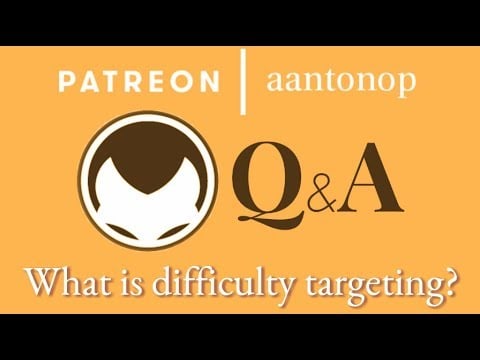How does difficulty targeting work? What determines the desired pattern? Should difficulty re-targeting still happen every 2016 blocks? Could difficulty changes (and hence profitability changes) make all miners drop out?
These questions are from the MOOC 7.2 and 9.2 sessions, which took place on February 26th 2017 and February 23rd 2018 respectively. Andreas is a teaching fellow with the University of Nicosia. The first course in their Master of Science in Digital Currency degree, DFIN-511: Introduction to Digital Currencies, is offered for free as an open enrollment MOOC course to anyone interested in learning about the fundamental principles.
If you want early-access to talks and a chance to participate in the monthly live Q&As with Andreas, become a patron: https://www.patreon.com/aantonop
RELATED:
What is mining? – https://youtu.be/t4p4iMqmxbQ
Miners, pools, and consensus – https://youtu.be/JHz7LM4ncLw
The mining process – https://youtu.be/L4Xtau0YMJw
Nonces, mining, and quantum computing – https://youtu.be/d4xXJh677J0
Honest nodes and consensus – https://youtu.be/KAhY2ymI-tg
Genesis block and coinbase transactions – https://youtu.be/strhfzJ56QE
Proof-of-work changes – https://youtu.be/AcaktuPdQrc
SegWit and fork research – https://youtu.be/OorLoi01KEE
What is the role of nodes? – https://youtu.be/fNk7nYxTOyQ
Why running a node is important – https://youtu.be/oX0Yrv-6jVs
Andreas M. Antonopoulos is a technologist and serial entrepreneur who has become one of the most well-known and respected figures in bitcoin.
Follow on Twitter: @aantonop https://twitter.com/aantonop
Website: https://antonopoulos.com/
He is the author of two books: “Mastering Bitcoin,” published by O’Reilly Media and considered the best technical guide to bitcoin; “The Internet of Money,” a book about why bitcoin matters.
THE INTERNET OF MONEY, v1: https://www.amazon.co.uk/Internet-Money-collection-Andreas-Antonopoulos/dp/1537000454/ref=asap_bc?ie=UTF8
[NEW] THE INTERNET OF MONEY, v2: https://www.amazon.com/Internet-Money-Andreas-M-Antonopoulos/dp/194791006X/ref=asap_bc?ie=UTF8
MASTERING BITCOIN: https://www.amazon.co.uk/Mastering-Bitcoin-Unlocking-Digital-Cryptocurrencies/dp/1449374042
[NEW] MASTERING BITCOIN, 2nd Edition: https://www.amazon.com/Mastering-Bitcoin-Programming-Open-Blockchain/dp/1491954388
Translations of MASTERING BITCOIN: https://bitcoinbook.info/translations-of-mastering-bitcoin/
Subscribe to the channel to learn more about Bitcoin & open blockchains!
Music: “Unbounded” by Orfan (https://www.facebook.com/Orfan/)
Outro Graphics: Phneep (http://www.phneep.com/)
Outro Art: Rock Barcellos (http://www.rockincomics.com.br/)
source

















This guys content is fantastic.. so impressed!
Question about bots… Leaving vast amounts of money on the exchanges is, as we all know, a bad Idea. But when running a bot using an dex api keys, surely there is no other way, leaving your capital at risk?
Audio sync or video issues anyone???
Greatest game ever played
Would have been handy to mention that finding a number lower than the target gets increasingly difficult the lower the target gets, based on the grounds of probability. The output of the hash function, although deterministic, is essentially probabilistic in terms of the hash value relative to the sample space — which is why zillions of mining machines are required to churn through the range of 'nonce' (ie the 'seed' that changes iteratively to process the entire sample space) values until the minimum target is obtained.
thanks
Can you explain the 21e800 mystery block hash that was created recently. Is super quantum computing playing a role already in Bitcoin or might this be a message from Satoshi.
0000000000000000000021e800c1e8df51b22c1588e5a624bea17e9faa34b2dc4a
Why aren't there 4 million views?
Please make a video about 00000000000000000021e800c1e8df51b22c1588e5a624bea17e9faa34b2dc4a event
Excellent answer to the profitability question Andreas. I hear this question all the time but I am not educated enough to know how to answer it. Now I do lol! Keep educating us.
Not to undermine your work but I'm pretty sure these questions have already been answered by yourself some time ago… Maybe it would be good to create an index of all the FAQs
Thank you Andreas! You have covered a very important topic.
I am glad that you promote yourself on all social media! Your cryptocurrency promotion and input in the industry is vast. I hardly know anyone with the same expertise and experience. I really enjoy listening to your lessons. Concerning pow, dont you think its a bit dated, pos is the future. I also see that privacy coin industry is booming and becoming a very interesting investment opportunity. I specifically look for lower cap projects with big and hyped communities. Kinda see a lot of fuzz around DeepOnion, have to study it closely…
Newbie question: If the mining program is fooled into thinking that a long time has passed since the last result … then would it make it easier to mine compared to anyone else? how is this situation avoided?
Re-uploaded? I swear I saw this video before!
This video is gold!
Thank you Andreas!
Fantastic explanation on mining difficulty. So what will happen when every single miner drops out? will the whole blockchain disappear? Please clarify as I'm not much into BTC mining. But I do mine DeepOnion, which is a privacy related cryptocurrency and is currently profitable for me.
this guy is a legend.
The difficulty retarget along side full blocks (when TX volume is high) and the futures market has created an attack vector on bitcoin BTC that didn't exist prior to December last year.
When the network is clogged with transactions, and an upcoming difficulty increase is about to make it harder to mine a block(swings as high as +20% we're common in late 2017).
"If" miner/s chooses to spam the network immediately after the difficulty adjustment and then shift mining hash to another chain, there is a possibility of chain death. The miner has five advantages
1. Bitcoin is unregulated so they do not need permission
2. There resources would no longer be split across chains
3. They can short the market from its high and as the network "stops" moving the price crashes and they make multiples on their position
4. They have two weeks before difficulty would readjust
5. They are the only market participants that can hold a long short position with little downside risk
6. They would be holding the alternative token that gives them another upside.
Another great video Andreas, please can you explain, to all the new people coming in, why it is harder to hash a smaller number as opposed to finding a lesser value under a reducing target range of numbers (the limbo dance, not to be confused with the lambo dance 🙂 )
Muchas gracias amigo ;)))
i´m mining without profit. but i didnt understood how to mine myself with free solar so far.
Check out fork.lol it shows when the difficulty retarget will occur (estimated date/time) and the estimated % change up or down.
if notification = Andreas then like + smash else wait for Andreas notification
while (true)
{
bitcoinAdoption++;
traditionalBanking–;
}
Great explanation about mining difficulty. We will share this the next time somebody asks about how mining difficulty works. Thank you Andreas!
mining has gotten so difficult for BTC, my hashflare account has ceased to payout. smh
What if the difficulty rises so much lets say 10x today's difficulty and then most of the miners drop out for any reason. Lets say 90% of the miners gone. Would the chain be in trouble of not being difficulty retargeted?
I have a question if you don't mind. How can a dex work across chains? Is this even possible? I can understand how a smart-contract based dex can work, like in Ethereum or EOS, within a single ecosystem (tokens for tokens in ethereum, for example), because the smart contract can make an atomic swap, by having the transaction either done or undone. But let's say Bitcoin/Ether pair. How can a dex do this? Someone has to hold the private key where the bitcoins have to be deposited. If that key is available publicly (since we're talking about a public dex which is absolutely not controlled by any central authority), then anyone can steal the deposited coins. So is the idea of dex with atomic swaps across chains possible? Has anyone succeeded at this at all? If yes, please explain how this is done technically in the sense of: Who holds the private keys, or please tell me that my understanding is wrong. Thank you!
if(Andreas) likes++;
var FabriceManzo = {like:"smashed", myBrain :"learnedsomething" } ;
First to smashed the like…..